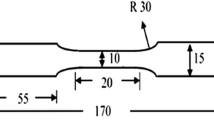Abstract
The present work deals with the damage tolerance characteristics of high strength aluminum alloy tempered in T6 and reversion condition. The fatigue experiments were carried out by applying a service simulating load spectrum, i.e., standard mini FALSTAFF loading. The crack propagation speed was found to be lower and the total crack propagation life was longer by 22% for reversion-treated alloy. The crack growth was also predicted to be using two parameter crack driving force approach. The fatigue data of these treated alloys under constant amplitude loading at various stress ratios were analyzed to obtain crack growth law. The predicted crack growth behavior was conservative and followed similar trend in both the alloys as observed in experiments. Predicted results of reversion-treated alloy also showed longer crack growth life. The modified microstructure after reversion treatment was attributed for the observed improvement in damage tolerance capability.









Similar content being viewed by others
References
Dursun T and Soutis C Mater. Des.56 (2014) 862.
Schijve J Int. J. Fatigue31 (2009) 998.
Puiggali M, Zielinski A, Olive J M, Renauld E, Desjardins D, and Cid M Corros. Sci.40 (1998) 805.
Rout P K, Ghosh M M, and Ghosh K S Mater. Charact.104 (2015) 49.
Bora C Reducing the susceptibility of alloys, particularly aluminium alloys, to stress corrosion cracking, US3856584, (1974).
Rout P K, Ghosh M M, and Ghosh K S Adv. Mater. Res.984-985 (2014) 529.
Nandana M S, Udaya Bhat K, and Manjunatha C M J. Mater. Eng. Perform.27 (2018) 1628.
Bray G H, Glazov M, Rioja R J, Li D, and Gangloff R P Int. J. Fatigue23 (2001) 265.
Sharma V M J, Sree Kumar K, Nageswara Rao B, and Pathak S D Mater. Sci. Eng. A528 (2011) 4040.
Chen Y, Weyland M, and Hutchinson C R Acta Mater.61 (2013) 5877.
Carvalho A L de M and Martins J de P Mater. Res.21 (2018).
Wang Y L, Pan Q L, Wei L L, Li B, and Wang Y Mater. Des.55 (2014) 857.
Xia P, Liu Z, Bai S, Lu L, and Gao L Mater. Charact.118 (2016) 438.
Heuler P and Klatschke H Int. J. Fatigue27 (2005) 974.
ASTM E1049-85 Annu. B. ASTM Stand. West Conshohocken, PA85 1 (2011).
Yang XR, Liu Z Y, Ying P Y, Li J L, Lin L H, and Zeng S M Trans. Nonferrous Met. Soc. China26 (2016) 1183.
Nandana M S, Udaya Bhat K, and Manjunatha C M Fatigue Fract. Eng. Mater. Struct.42 (2018) 719.
Chen X, Liu Z, Lin M, Ning A, and Zeng S J. Mater. Eng. Perform.21 (2012) 2345.
Pokorny P, Vojtek T, Nahlik L, and Hutar P Eng. Fract. Mech.185 (2017) 2.
Desmukh M N, Pandey R K, and Mukhopadhyay A K Mater. Sci. Eng. A435-436 (2006) 318.
Nandana M S, Udaya Bhat K, and Manjunatha C M ICAF 2019 – Structural Integrity in the Age of Additive Manufacturing (Springer International Publishing) (2020).
Walker K ASTM STP 462, Am. Soc. Test. Mater. 1 (1970).
Elber W Eng. Fract. Mech.2 (1970) 37.
Li Y, Wang H, and Gong D Eng. Fract. Mech.96 (2012) 500.
McClung R C Metall. Trans. A22 (1991) 1559.
Dinda S and Kujawski D Eng. Fract. Mech.71 (2004) 1779.
Sree P C R and Kujawski D A two-parameter fatigue crack growth correlation using ∆K and Kmax parameters p 11 (2014).
Kujawski D Int. J. Fatigue23 (2001) S239.
Newman J Methods Model. Predict. Fatigue Crack Growth under Random Loading, STP748-EB, Chang. J. Hudson, C., Ed., ASTM Int. West Conshohocken, PA748 (1981) 53.
Acknowledgements
A sincere gratitude is extended for the support provided by the chairman, CSIR-NAL and NITK for providing equipment facility.
Author information
Authors and Affiliations
Corresponding author
Additional information
Publisher's Note
Springer Nature remains neutral with regard to jurisdictional claims in published maps and institutional affiliations.
Rights and permissions
About this article
Cite this article
Nandna, M.S., Bhat, K.U. & Manjunatha, C.M. Damage Tolerance Capability of Retrogression and Re-aged 7010 Aluminum Alloy Under FALSTAFF Loading. Trans Indian Inst Met 73, 1073–1080 (2020). https://doi.org/10.1007/s12666-020-01946-4
Received:
Accepted:
Published:
Issue Date:
DOI: https://doi.org/10.1007/s12666-020-01946-4




